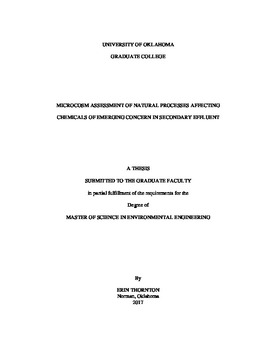| dc.description.abstract | The fight for new water sources is over, reclaimed water is next. Currently, the City of Norman supports its water needs via Lake Thunderbird (LT) and the Central Oklahoma Aquifer System (COAS). In times of peak demand, the City of Norman can purchase treated drinking water from Oklahoma City, but state-wide drought threatens the longevity of this water source. In response, the City of Norman contracted an engineering firm to draft a strategic water supply plan. Several portfolios were produced, but the most promising one called for the augmentation of the potable water supply through indirect potable water reuse. A portion of the effluent from the Norman Water Reclamation Facility would be discharged into an environmental buffer, Dave Blue Creek. Currently, the Norman Water Reclamation Facility is not designed for the removal of chemicals of emerging concern (CEC) which are detected in effluent at trace amounts (ng/L parts per trillion or ppt).
Microcosm studies were setup to simulate the behavior of 98 CEC when incubated with Dave Blue Creek sediment and photosynthetically active radiation lights. Erlenmeyer flasks were filled with treated effluent and sediment fractions less than 0.25 mm with a 2:1 ratio w/v. The flasks were incubated for 15 days on an orbital shaker at 125 rpm. Sorption (SED) and photodegradation (PAR + SED and PAR + Effluent) microcosms were run separately.
Photodegradation appeared to be the most effective pathway for CEC detection reduction. When evaluated by class (e.g., EDCs, PPCPs, stimulants, preservatives, sweeteners, pesticides, and flame retardants) the effects of sorption and photodegradation varied. Sorption appeared to be an important pathway for decreasing the number of pesticide detection. The effects of photodegradation seemed most effective at reducing PPCP detections. EDC, flame retardant, and preservative detects were susceptible to the synergistic effects of photodegradation and sorption, and attenuation of artificial sweeteners and stimulants were negligible for both mechanisms. | en_US |
